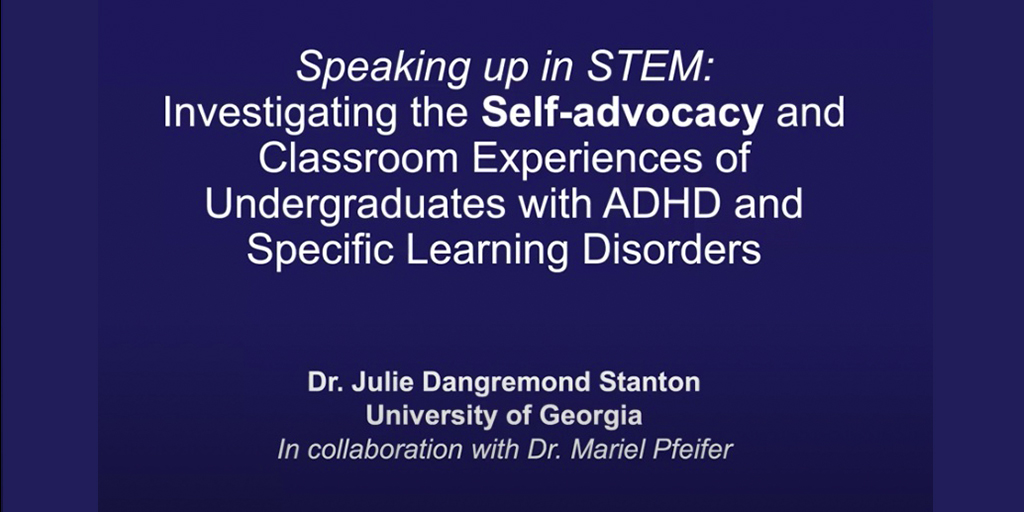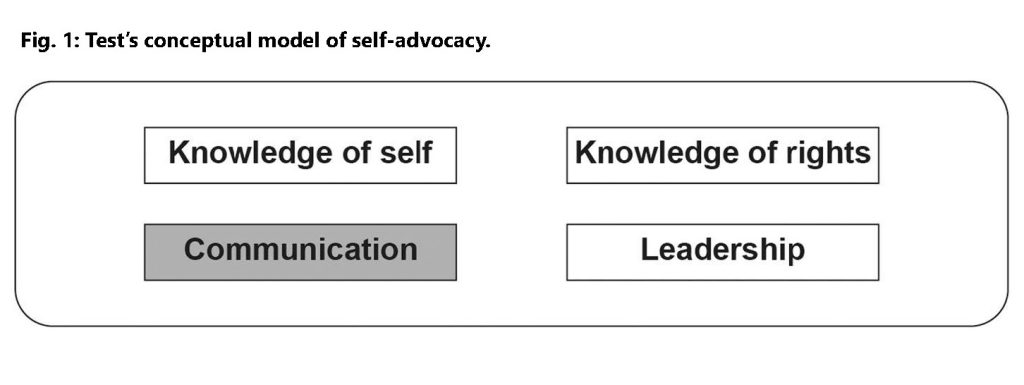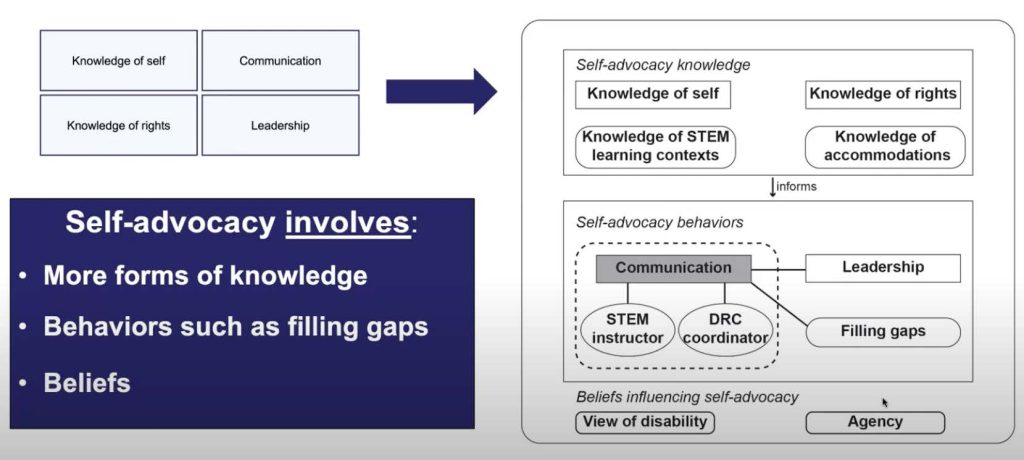Speaking Up in STEM: Investigating the Self-advocacy and Classroom Experiences of Undergraduates with ADHD and Specific Learning Disorders

View recording on Panopto (restricted to the MIT Community)
On Thursday, October 26, we hosted Dr. Julie Dangremond Stanton to discuss how students with disabilities engage in self-advocacy in the context of undergraduate STEM courses.
In her opening remarks, Dr. Julie Stanton explained why she believes it is important to investigate why students with disabilities are less likely to graduate with STEM degrees. First, Stanton says, it is an issue of equity and justice. The number of college students with reported disabilities has increased from 6% in 1996 to about 20% in 2016. (NSF, 2021) Yet, they are still underrepresented in STEM. The Americans with Disabilities Act (ADA), passed in 1990, requires colleges and universities to provide access to reasonable accommodations to those who need them. (Accommodations are modifications to a curriculum format or environment that give students with disabilities access to college instruction; for example, allowing for extended time on an exam.) However, data have shown that STEM students with disabilities are less likely to use accommodations than students with disabilities in other majors. (Newman et al., 2015) Stanton added that lower rates of accommodation use could affect students’ retention in STEM, hence limiting scientific innovation and discovery.
Self Advocacy
When students with disabilities transition from high school to college, they become solely responsible for their accommodations, and many students, Stanton emphasized, must learn to manage their accommodations for the first time. Wherein K-12 institutions, the school is responsible for providing the accommodations necessary for their success, institutions of higher education are only responsible for providing access to accommodations. Thus, the management of accommodations in higher ed relies strongly on self-advocacy, defined by Test et al. (2005) as “taking action to ensure one receives the accommodations and support that is essential for student success.” However, this model of self-advocacy (see fig. 1) had not previously been empirically tested, and how students with disabilities self-advocate is not well understood. So Stanton’s lab designed a qualitative study to investigate the applicability of this original model of self advocacy to students with disabilities and their access to accommodations in STEM courses.

A Revised Model
To this end, Pfeifer et al. (2020) conducted semi-structured interviews of 25 STEM students with ADHD and/or SLD (specific learning disability in reading, writing, or math). The interviews included questions that probed students’ use of self-advocacy to receive needed accommodations. These learning disability profiles are the most common in college and often co-occur (for example, ADHD and dyslexia). They are also examples of non-apparent disabilities, meaning they are not physically visible. Therefore, these students must self-disclose their disability in order to access accommodations, which in itself can be a barrier for some students.
Limitations and considerations
Before sharing the results, Stanton mentioned a few limitations of this study. 1) This is one study of 25 students at one institution. 2) Different institutions have different policies, and one can not assume this to be how other students at other institutions experience self-advocacy. 3) All participants in this study had non-apparent disabilities and, therefore, the findings may not apply to students who have visible disabilities. However, Stanton emphasized, this work provides foundational knowledge to help generate hypotheses for future research and offers insights into student experiences that can help STEM instructors be more aware of how to support all of their students.
Results and implications
When Stanton compared their findings to the model of self-advocacy defined by Test et al. (2005), each of the original components identified was represented in the new data; however, Stanton’s findings were more complex, and modifications to the original model were needed. (see fig. 2) In addition to knowledge of self and rights, they found that students required knowledge of STEM learning contexts (e.g., knowledge of the specific affordances of formative and summative assessments) and accommodations (e.g., knowledge of possibilities for extended exam time) for successful self-advocacy. (Pfeifer et al., 2020). The researchers also found that additional behaviors, such as ‘filling gaps,’ were necessary. An example of this behavior reported by students was to set up a note-taking system with peers when the note-taking accommodations provided by the school were deemed inadequate by the students. Lastly, all these forms of knowledge and behaviors are informed by students’ own beliefs about and views of their specific disabilities.

Environmental factors
Next, Stanton’s group wanted to look at additional factors that might influence students’ self-advocacy behaviors. They found that peers, STEM instructors, disciplinary norms and values, and accommodation implementation, among others, could all act as barriers to a student’s self-advocacy. Stanton highlighted two of the barriers that students reported – STEM instructors and accommodation implementation (Pfeifer et al., 2021):
STEM instructors as barriers to self-advocacy
- STEM instructors were seen as less informed about disabilities than colleagues from other disciplines.
- STEM instructors were reported as more likely to use dismissive or hurtful language.
- STEM instructors were reported to directly discourage the use of accommodations in lab environments.
Accommodation implementation as a barrier to self-advocacy
- The requirement that students disclose their disability as the first interaction with an instructor.
The sense of being “outed” to their peers when their accommodation requires taking exams in a different location. - Lack of resources that may not be available if the accommodation location is not in the classroom. (For example, a periodic table in the classroom that can be used as a reference.)
Active learning
Finally, Stanton shared data they collected from participants about how active learning practices affect student perceptions of learning. Of the 25 participants, 20 reported that they learned best in STEM courses that incorporated at least some active learning components. However, these perceptions varied widely, and the variations were based not on the type of active learning practice but rather on how the practices were implemented. For example (Pfeifer et al., 2023):
Audience response systems (clickers):
- Posing multiple-choice questions and explaining the correct answer to the entire class was helpful for students’ metacognition and/or for monitoring their own learning.
- However, providing the correct answers to questions without explaining the reasoning behind it acted as a barrier to learning.
Group work:
- Working with peers was found to be highly motivating for some individuals, for example, some students reported that peer-to-peer learning opportunities supported metacognition.
- However, some roles in group work, like reading aloud for someone with dyslexia, can be anxiety-provoking and act as a barrier to learning.
Practical Suggestions for Faculty and Staff
In the final few minutes of her talk, Stanton offered some practical suggestions for ways faculty and staff can encourage students with disabilities to self-advocate for the accommodations they need to be successful learners in STEM courses:
- Instructors can seek out information about disabilities, especially non-apparent ones like ADHD and SLD, and can learn more about instructors’ responsibilities in supporting student learning.
- Instructors can create a supportive classroom environment by making general in-class statements about available resources to students who need them, and should include this information in the course syllabus.
- Instructors can help students gain awareness and knowledge of accommodations in STEM learning contexts by explaining how they can be used in lab and recitation.
- Instructors can share strategies with students to support them in filling gaps (e.g., facilitate group study formation).
- When engaging students in group work, instructors can set guidelines and expectations for member participation and allow students to opt out of certain roles that may be a barrier to their learning (e.g., reader, reporter, etc.)
References
National Center for Science and Engineering Statistics (NCSES). 2023. Diversity and STEM: Women, Minorities, and Persons with Disabilities 2023. Special Report NSF 23-315. Alexandria, VA: National Science Foundation. https://ncses.nsf.gov/wmpd
Newman, L. A., & Madaus, J. W. (2015). Analysis of factors related to receipt of
accommodations and services by postsecondary students with disabilities. Remedial and Special
Education, 36(4), 208-219. DOI: https://doi.org/10.1177/0741932515572912
Pfeifer, M. A., Cordero, J. J., & Stanton, J. D. (2023). What I Wish My Instructor Knew: How Active Learning Influences the Classroom Experiences and Self-Advocacy of STEM Majors with ADHD and Specific Learning Disabilities. CBE—Life Sciences Education, 22(1), ar2. https://www.lifescied.org/doi/full/10.1187/cbe.21-12-0329
Pfeifer, M. A., Reiter, E. M., Cordero, J. J., & Stanton, J. D. (2021). Inside and out: Factors that support and hinder the self-advocacy of undergraduates with ADHD and/or specific learning disabilities in STEM. CBE—Life Sciences Education, 20(2), ar17. https://www.lifescied.org/doi/10.1187/cbe.20-06-0107
Pfeifer, M. A., Reiter, E. M., Hendrickson, M., & Stanton, J. D. (2020). Speaking up: A model of self-advocacy for STEM undergraduates with ADHD and/or specific learning disabilities. International Journal of STEM Education, 7(1), 1-21. https://stemeducationjournal.springeropen.com/articles/10.1186/s40594-020-00233-4
Test, D. W., Fowler, C. H., Wood, W. M., Brewer, D. M., & Eddy, S. (2005). A conceptual framework of self-advocacy for students with disabilities. Remedial and Special Education, 26(1), 43–54. https://doi.org/10.1177/07419325050260010601

